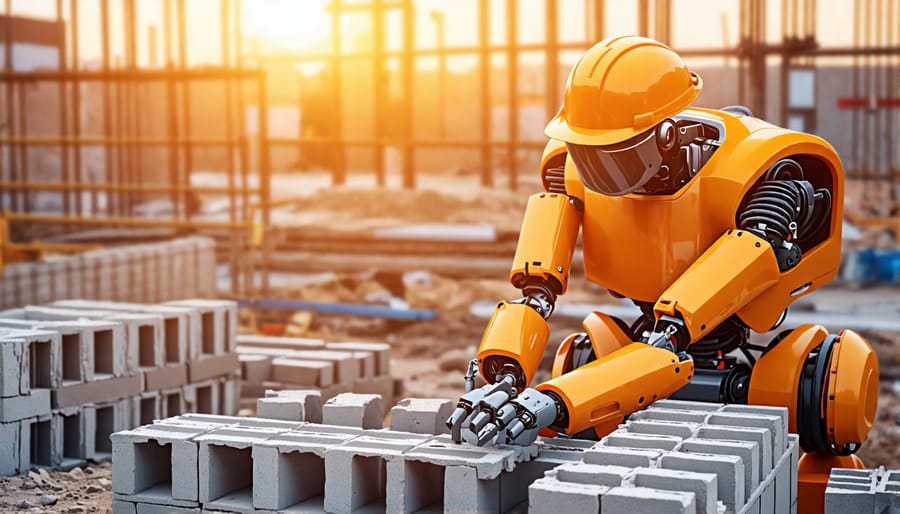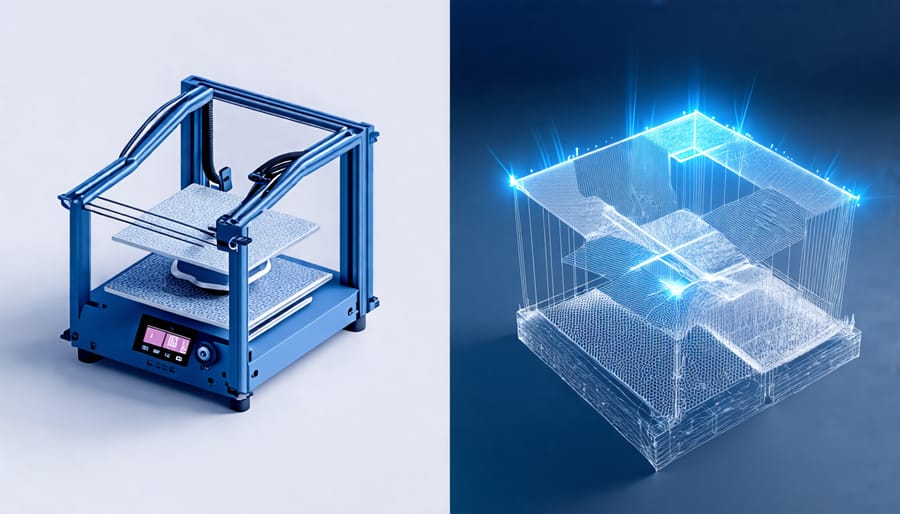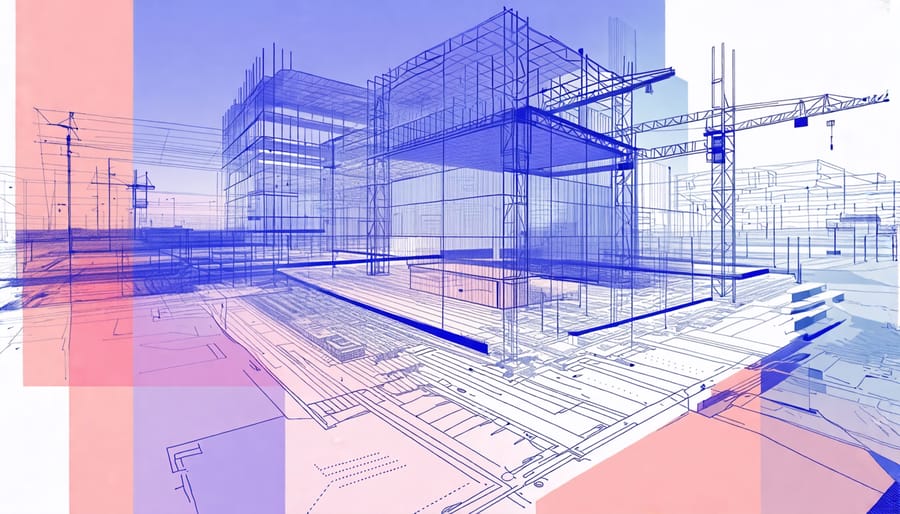Implement advanced BIM tools to enhance project visualization and coordination, reducing errors and costs. Integrate AI and machine learning to optimize resource management and predict maintenance needs, improving efficiency across projects. Leverage IoT-enabled devices for real-time monitoring of construction sites, ensuring safety and streamlining operations. Embrace “Construction 4.0” technologies by exploring digital twin applications for smarter decision-making and enhanced collaboration. Foster a culture of continuous learning to stay ahead of emerging trends, equipping teams with the skills necessary to harness these innovative tools effectively.
The Rise of Robotics in Construction
Automation in Building Tasks
The integration of robots in construction is transforming how projects are executed by taking repetitive and hazardous tasks off human hands. Automated robots, like those used for bricklaying or rebar tying, enhance precision and efficiency while reducing onsite risks. These machines can operate tirelessly, ensuring consistent quality and accelerating project timelines. For instance, autonomous drones are redefining site surveys and inspections, providing real-time data and minimizing the need for dangerous manual checks at heights. In environments where human safety is compromised, such as demolition or hazardous materials handling, robots act as invaluable substitutes. Through expert interviews, construction professionals highlight a shift towards embracing automation as a strategic asset, augmenting human capabilities and ensuring safer work conditions. Moreover, in-depth case studies demonstrate how adoption of robots on construction sites is not just a futuristic trend but a practical solution to labor shortages and productivity challenges, heralding a new era of efficiency in the industry.

Robotic Process Innovations
In the rapidly evolving landscape of construction technology, robotic process innovations stand at the forefront, redefining traditional methodologies and enhancing efficiency and precision. Leading the charge are bricklaying robots, which have demonstrated remarkable capabilities in automating repetitive tasks typically labor-intensive and time-consuming for human workers. These robots are not only capable of laying hundreds of bricks per hour with high precision, but they also significantly reduce waste and human error, offering a compelling value proposition for large-scale projects.
Equally transformative is the rise of autonomous machinery on construction sites. From bulldozers to cranes, these machines are increasingly equipped with sophisticated sensors and AI algorithms, allowing for intelligent decision-making and operation with minimal human intervention. This technological leap not only enhances safety by removing workers from hazardous environments but also drives productivity by enabling continuous work cycles and optimizing resource use. As these innovations continue to mature, industry leaders foresee a paradigm shift where robotic process technologies will become integral to construction workflows, pushing the boundaries of what is possible in architectural design and project execution.
3D Printing: Revolutionizing Building Materials

Advancements in 3D Printing Technology
Recent advancements in 3D printing technology are reshaping the construction industry by revolutionizing materials and techniques. The development of novel materials like advanced concrete mixtures and sustainable polymers enables the creation of intricate architectural designs that were once unreachable using traditional methods. These cutting-edge materials support complex geometries, providing architects and engineers unprecedented flexibility. Enhanced printing techniques, such as laser-assisted and automated on-site systems, further augment precision and efficiency, reducing labor costs and construction time significantly. As demonstrated in several pivotal case studies, integrating these technologies not only streamlines workflows but also contributes to sustainable practices by minimizing waste and optimizing resource use. Through expert insights, we glimpse the transformative potential of 3D printing in future construction projects, paving the way for innovative and sustainable urban landscapes.
Case Studies of 3D Printed Structures
One of the most compelling examples of 3D printing in construction is the development of affordable housing solutions. For instance, a company in the Netherlands successfully completed a residential complex featuring 3D-printed elements, showcasing not only design flexibility but also cost efficiency. Similarly, in Dubai, the 3D Printing Office Building stands as a testament to the technology’s potential in reducing construction time and minimizing waste. Furthermore, the creation of eco-friendly structures like Italy’s TECLA house, built entirely with sustainable materials, underscores its environmental benefits. These projects highlight the transformative potential of 3D printing, supporting innovation while addressing contemporary challenges in building practices. As the industry evolves, these pioneering uses set a precedent for future construction methodologies.
Sustainable Construction Innovations
Green Building Technologies
Green building technologies are revolutionizing the construction sector by integrating sustainability with advanced engineering practices. Among these innovations, energy-efficient materials are at the forefront, dramatically reducing the environmental footprint of buildings. Materials like high-performance insulation and reflective roofing not only optimize energy consumption but also contribute to significant cost savings over a building’s lifespan. Furthermore, the development of low-carbon concrete is gaining momentum as it offers a sustainable alternative to traditional concrete, minimizing CO2 emissions without compromising structural integrity.
These technologies not only fulfill ecological mandates but also open up new energy-efficient careers in the construction sector. The integration of these advancements demands expert knowledge and innovative implementation strategies, ultimately aiming to achieve net-zero emissions in upcoming projects. Case studies highlight successful applications of these technologies, underscoring the potential for green building technologies to transform industry norms. As construction professionals, staying informed and adaptable is essential to fully leverage the benefits of these cutting-edge developments and to contribute meaningfully to a sustainable future in construction.
Smart Building Systems
As construction technology continues to evolve, smart building systems represent a critical innovation transforming the industry. These intelligent systems optimize energy consumption and environmental controls through advanced sensors, machine learning algorithms, and IoT connectivity. By integrating these technologies into building management systems, real-time data is utilized to enhance energy efficiency and occupant comfort. For construction professionals, understanding and implementing these systems is essential for staying competitive and meeting regulatory demands for sustainability.
One compelling case study highlights the implementation of smart HVAC systems in commercial buildings, where the use of data analytics and adaptive algorithms resulted in a 30% reduction in energy consumption. This underscores the potential of smart technologies to deliver both environmental benefits and cost savings. Expert interviews reveal that architects and engineers are increasingly prioritizing the integration of smart systems during the design phase, recognizing their contribution to building longevity and adaptability. As the industry moves forward, investing in and understanding intelligent building systems will be key to shaping a sustainable built environment.
The Role of Digital Twins and AI

Building Information Modeling (BIM) Enhancements
Building Information Modeling (BIM) is undergoing transformative enhancements through the integration of AI and digital twin technologies. AI-driven BIM is revolutionizing how construction professionals analyze vast datasets, leading to more precise and efficient project planning. By automating complex processes, AI reduces human error and enhances decision-making, thereby improving project outcomes. Digital twins take this a step further by creating dynamic, real-time models of buildings, allowing architects and engineers to simulate and predict performance issues before they arise. An insightful case study shows a major urban development project using digital twins to optimize energy efficiency, thereby reducing operational costs significantly. As these technologies continue to evolve, they promise to reshape industry practices, driving innovation and sustainability in construction projects across the globe.
Predictive Analytics for Project Management
Predictive analytics is revolutionizing project management in construction by enabling more accurate planning and enhanced risk management. By leveraging data from past projects, predictive models can forecast potential delays and budget overruns, allowing project managers to make informed decisions. This leads to optimized resource allocation and proactive mitigation strategies. For example, a large infrastructure project might use predictive analytics to assess weather patterns, predicting construction disruptions and adjusting schedules accordingly. The technology also aids in identifying risks early, such as supply chain issues or workforce shortages, reducing the likelihood of costly setbacks. As a result, construction professionals can deliver projects on time and within budget more consistently, improving overall efficiency and client satisfaction. Predictive analytics is thus becoming an indispensable tool for future-ready construction management.
Conclusion
The exploration of groundbreaking technologies within the construction industry underscores a transformative potential poised to redefine building practices and project management. From advanced robotics and automation to cutting-edge materials like self-healing concrete, these innovations offer unprecedented efficiency, sustainability, and safety enhancements. As expert interviews and in-depth case studies have illustrated throughout this article, adopting such technologies can significantly optimize resource utilization and streamline workflows. For architects and engineers, these tools not only enhance design precision but also facilitate more ambitious projects, pushing the boundaries of architectural possibilities. As decision-makers and project managers navigate through a rapidly evolving landscape, understanding and integrating these technologies are imperative for maintaining competitive advantage and fostering an adaptable business model. Moving forward, the challenge lies in implementing these advancements while ensuring seamless integration with existing systems and workforce training. Ultimately, these emerging technologies herald a new era in construction, promising to reshape the industry’s future with innovative solutions and long-term benefits.

